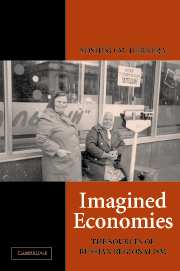Book contents
- Frontmatter
- Contents
- List of Tables
- List of Figures and Maps
- List of Acronyms
- Note on Transliteration
- Acknowledgments
- Imagined Economies
- Introduction
- 1 Regionalism in the Russian Federation: Theories and Evidence
- 2 Imagined Economies: Constructivist Political Economy and Nationalism
- 3 Breaking the Soviet Doxa: Perestroika, Rasstroika, and the Evolution of Regionalism
- 4 To Each His Own: The Development of Heterogeneous Regional Understandings and Interests in Russia
- 5 Imagined Economies in Samara and Sverdlovsk: Differences in Regional Understandings of the Economy
- 6 Regional Understandings of the Economy and Sovereignty: The Economic Basis of the Movement for a Urals Republic
- 7 Regional Understandings, Institutional Context, and the Development of the Movement for a Urals Republic
- Conclusion
- Appendix Tables
- Index
- Cambridge Cultural Social Studies
1 - Regionalism in the Russian Federation: Theories and Evidence
Published online by Cambridge University Press: 22 September 2009
- Frontmatter
- Contents
- List of Tables
- List of Figures and Maps
- List of Acronyms
- Note on Transliteration
- Acknowledgments
- Imagined Economies
- Introduction
- 1 Regionalism in the Russian Federation: Theories and Evidence
- 2 Imagined Economies: Constructivist Political Economy and Nationalism
- 3 Breaking the Soviet Doxa: Perestroika, Rasstroika, and the Evolution of Regionalism
- 4 To Each His Own: The Development of Heterogeneous Regional Understandings and Interests in Russia
- 5 Imagined Economies in Samara and Sverdlovsk: Differences in Regional Understandings of the Economy
- 6 Regional Understandings of the Economy and Sovereignty: The Economic Basis of the Movement for a Urals Republic
- 7 Regional Understandings, Institutional Context, and the Development of the Movement for a Urals Republic
- Conclusion
- Appendix Tables
- Index
- Cambridge Cultural Social Studies
Summary
Federalism and sovereignty movements in Russia during 1990–3 have mainly been examined in terms of the actions of non-Russian ethnic republics. To gain a deeper understanding of the economic basis of sovereignty and autonomy movements for all regions of Russia, in this chapter I test existing explanations on an original data set that captures the spectrum of sovereignty-oriented activism among the Russian regions (oblasts and krais). I show that economic variables found in traditional quantitative data sets and used in previous explanations do not explain the pattern of Russian regionalism very well, but I analyze the complexity of economic data in Russia to suggest a different approach to the role of economic factors in sovereignty movements.
Regions and Federalism in the USSR and Russia
Any discussion of regionalism and federalism in the USSR and Russia must begin with an acknowledgment of the fact that the USSR was territorially divided in a very complicated way. The administrative and ethnic territorial divisions that constituted the state were irregular, uneven, and subject to change over the course of Soviet history. They were also fundamental in making and breaking the Soviet state.
Beyond urban and rural districts, there were, broadly speaking, three main administrative levels in the USSR, although not all levels existed in every territorial unit. As shown in Table 1.1, as of 1989, there were 15 union republics (Sovetskaia Sotsialisticheskaia respublika or Soviet Socialist Republic, SSR), whose specific names and institutional structures corresponded to ethnic groups (e.g., Estonian SSR, Ukrainian SSR).
- Type
- Chapter
- Information
- Imagined EconomiesThe Sources of Russian Regionalism, pp. 20 - 57Publisher: Cambridge University PressPrint publication year: 2004



